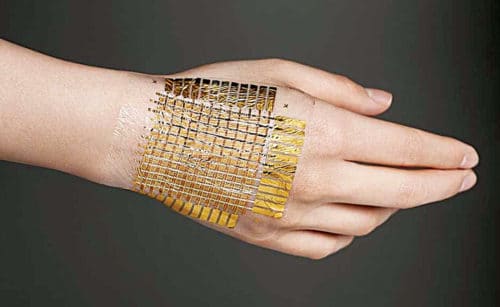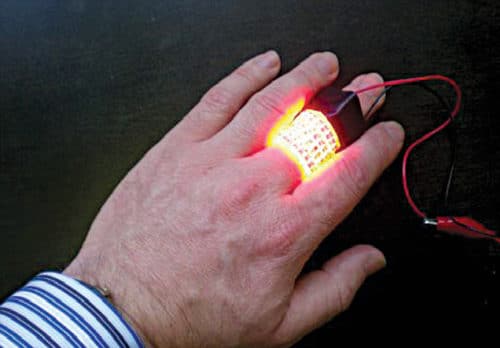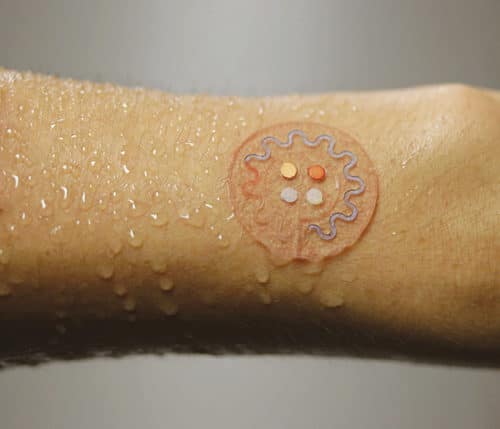The various types of artificial electronic skins being developed offer amazing properties and applications
Skin plays an important role in mediating our interactions with the world. Specifically, human skin can sense pressure and temperature, stretch, and heal itself. Electronic skin is a thin electronic material that mimics human skin in one or more ways. Recreating the properties of skin using electronic devices could have profound implications in various fields like robotics, prosthetics and medicine. The artificial skin could one day be used on robotic hands capable of detecting diseases or intoxication of humans via touch.
The pursuit of artificial skin has inspired innovations in materials to imitate skin’s unique characteristics, including mechanical durability and stretch ability, biodegradability, and the ability to measure a diversity of complex sensations over large areas. New materials and fabrication strategies are being developed to make mechanically compliant and multifunctional skin-like electronics, and improve brain-machine interfaces that enable transmission of skin’s signals into the body.
Scientists and engineers have made progress toward materials that can detect pressure, blend with surroundings, measure body temperature, and do much more. Here is a summary.

Self-healing electronic skin
Stanford University researchers have developed an electronic skin capable of healing itself by combining a self-healing plastic and nickel, a conductive metal. Unlike self-healing polymers developed by other researchers, this skin did not require a high temperature or UV light to activate.
The individual plastic molecules of the skin break apart relatively easily, but the bonds also easily reform. Cut pieces healed to 75 per cent strength within a few seconds and fully in less than 30 minutes when pressed together at room temperature. Additionally, the process could be repeated many times—in experiments the material showed near-perfect healing after 50 breaks. Other self-healing materials alter their structures in the process and thus can heal only once.
In addition to being self-healing, the electronic skin was pressure-sensitive and very flexible. It was the first material to exhibit all these properties at the same time. It was also the first conductive self-healing polymer. The e-skin could detect both downward pressure and pressure from bending; thus, in principle, it could detect both the pressure and angle of a normal human handshake.
According to the research team, the material could be useful in prosthetics and creating self-healing wires for electronic devices.
Lighting electronic skin
Researchers from the University of California at Berkeley have created an electronic skin that lights up when touched. Pressure triggered a reaction in the skin that lit up blue, green, red and yellow LEDs; as pressure increased the lights got brighter.
The material was composed of synthetic rubber and plastic, and was thinner than a piece of paper. Sandwiched between layers, organic LEDs were lit by semiconductor-enriched carbon nanotubes and a conductive silver ink. The skin was made up of hundreds of circuits, each of which contained a pressure sensor, a transistor and a tiny LED. Pressure changed the resistance of the sensor, thereby changing the amount of electricity flowing into the LED.
The team suggested that the invention could be useful in skin for prosthetic limbs and robotics. One of the major problems with these kinds of light films in the past, though, was that these only lasted a matter of hours when exposed to normal air.
Making any piece of ultra-stretchy electronics often involves sandwiching materials together to produce something with the right properties, whether it’s for a red light or a method of sensing pressure. In this case, the researchers added a new protective coating, called a passivation layer, to various kinds of e-skin. The coating kept out oxygen and water vapour well enough to keep the light working for several days. Researchers report that this power LED film also produced less heat and consumed less power than previous efforts. The coating they used can also work on e-skin that does more than just light up.

Sweating electronic skin
A Northwestern University research team has developed a first-of-its-kind soft, flexible microfluidic device that easily adheres to the skin and measures the wearer’s sweat to show how his body is responding to exercise.
A little larger than a quarter and about the same thickness, the simple, low-cost device analyses key biomarkers to help the user decide quickly if any adjustments, such as drinking more water or replenishing electrolytes, need to be made or if something is medically awry.
Designed for one-time use of a few hours, the device, placed directly on the skin of the forearm or back, even detects the presence of a biomarker for cystic fibrosis. In the future, it may be more broadly used for disease diagnosis.’

Sensory electronic skin
Researchers at the Ulsan National Institute of Science and Technology have developed an electronic skin that can detect changes in both temperature and pressure. The skin’s composites are made of a polymer as well as reduced graphene oxide. Thanks to that, the artificial skin can detect not only sensory changes created by water droplets falling at different pressures and temperatures but also the tiniest amount of pressure such as human hair’s. This makes the skin perfect for future caregiver robots. Or, when attached to a human wrist, it can also be used to monitor pulse pressure by detecting the changes in skin temperature that occur when blood vessels dilate or constrict.
Researchers have created a wearable device that is as thin as a temporary tattoo and can store and transmit data about the wearer’s movements, receive diagnostic information and release drugs into skin. Similar efforts to develop electronic skin abound, but the device is the first that can store information and also deliver medicine—combining patient treatment and monitoring. Its creators say that the technology could one day aid patients with movement disorders such as Parkinson’s disease or epilepsy.
The researchers constructed the device by layering a package of stretchable nanomaterials—sensors that detect temperature and motion, resistive RAM for data storage, micro-heaters and drugs—onto a material that mimics the softness and flexibility of the skin.

Sensing magnetic fields
There are actually several more senses than humans’ basic senses of touch, sight, hearing, taste and smell. One that humans don’t inherently have is magnetoception—the ability to perceive magnetic fields. Found in certain bacteria, migratory birds, fish and invertebrates, it provides them a better sense of navigation and orientation.
Researchers at the Leibniz Institute for Solid State and Materials Research in Germany describe a new electronic skin that provides a sense of magnetic fields. The electronic skin contains an array of magnetoresistive sensor foils that sense both static and dynamic magnetic fields. The sensors are made from layers of cobalt and copper, with polyethylene terephthalate (PET) film. Information about the sensor’s proximity to a magnetic field is transmitted wirelessly to an external device that has LED indicators, giving a visual representation of the distance.
The skin is only about two micrometres thick, which is about one-fifth as wide as a single human hair. A square metre of the material weighs only three grams, which makes it light enough to rest on a soap bubble. It is also incredibly elastic, as it is able to stretch over 270 per cent in multiple directions over 1000 times before wearing out. Conversely, sensors are still able to function properly if the skin is crumpled up. This makes them well-suited for use on the skin.
Multitasking skin
Researchers in Korea have developed their own compact electronic skin that multitasks like human skin, sensing pressure, temperature and sound (which is just air pressure, really) simultaneously.
The scientists took design cues from fingertips—home to some of the most sensitive skins on the human body. Fingerprint ridges help amplify vibrations, making sense of touch extremely fine-grained, so we can tell crinkly from grainy from velvety. Plus, the layers of dermis and epidermis underneath interlock with each other, providing more points of contact.
Colour-shifting electronic skin
The ability of animals like chameleons, octopus and squid to change their skin colour for camouflage, temperature control or communication is well known. While science has been able to replicate these abilities with artificial skin, the colour changes are often only visible to the naked eye when the material is put under huge mechanical strain.
Researchers from Tsinghua University have developed a new type of user-interactive electronic skin that can change colour. The changes are perceptible to the humen eye without much level of strain. The skin could have applications in robotics, prosthetics and wearable technology.
Graphene, with its high transparency, rapid carrier transport, flexibility and large specific surface area, shows application potential for flexible electronics, including stretchable electrodes, super capacitors, sensors and optical devices. Researchers employed flexible electronics made from graphene, in the form of a highly-sensitive resistive strain sensor, combined with a stretchable organic electrochromic device. On exploring the substrate (underlying) effect on the electromechanical behaviour of graphene, they found subtle strain—between zero and 10 per cent—was enough to cause an obvious colour change, and the RGB value of the colour quantified the magnitude of the applied strain.

Powering the electronic skin
Stanford research team has developed a stretchable solar cell that could be used to power the electronic skin. An accordion-like micro-structure allowed the cells to stretch up to 30 per cent without damage. The team also added biological and chemical sensors to the skin to supplement pressure sensors.Another research team has announced an electronic patch for monitoring patients’ vital signs. Described as ‘electric skin,’ the device was created by embedding sensors in a thin film and then placing the film on a polyester backing similar to those found on temporary tattoos. A small coil provided power through induction. In tests, the device stayed in place for 24 hours without adhesives, relying instead on the Vander Waals force, and was flexible enough to move with the skin it was placed on.
Emerging applications
Electronic skins can monitor a person’s heartbeat, brain activity, muscle contractions and more without the need for bulky conventional electronics. In addition to patient monitoring, these could be used to detect speech by sensing vibrations in the larynx and emit heat to help in healing.
Electronic skin is no thicker than a human hair and can be applied as easily as a temporary tattoo. It sticks without the need for any glue, and can flex and stretch without breaking. In essence, electronic skin consists of mechanically flexible sensor networks that can wrap around irregular surfaces, and spatially map and quantify various stimuli.
Long-term vision is to heterogeneously integrate a wide range of sensor networks (pressure, strain, light, temperature and humidity) and associated electronics on large-area plastic substrates using process schemes that are compatible with conventional silicon or LCD manufacturing lines. The sensor elements are based on a silicon, oxides, metals, piezoelectrics and/or organic materials that are processed at less than 35°C. The resulting electronic skin may find a wide range of applications in interactive input/control devices, smart wallpapers, robotics and medical/health monitoring devices.
Japanese researchers have taken a step closer to creating electronic skin by employing flexible electronics that can be worn as a second skin for biomedical and other applications. The aim is to make electronic skin as much a part of our daily lives as the clothes we wear.
If this happens, athletes will use electronic skin to view their heart rates, sugar levels and work rate. It could provide doctors with continuous data on patients’ vital signs without the need for repeatedly attaching and removing medical equipment. The rest of us might employ the electronic skin to monitor body health metrics. Meanwhile, engineers could put down their tablets when doing tricky repair work and instead view maintenance procedures displayed on their arms. Such is the promise of ultra-thin, flexible and non-constraining electronic skin!





